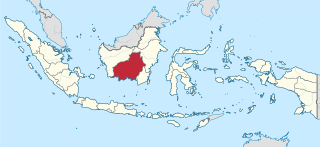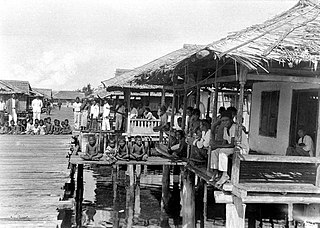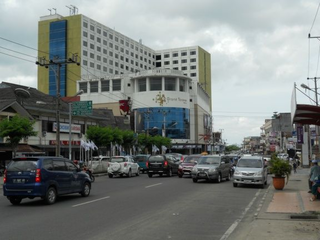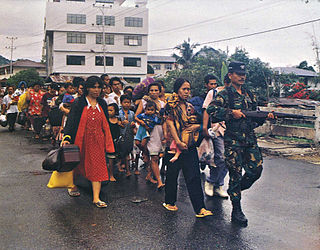Related Research Articles

West Kalimantan is a province of Indonesia. It is one of five Indonesian provinces comprising Kalimantan, the Indonesian part of the island of Borneo. Its capital city is Pontianak. The province has an area of 147,307 km2, and had a population of 4,395,983 at the 2010 Census and 5,414,390 at the 2020 Census; the official estimate as at mid 2021 was 5,470,797. Ethnic groups include the Dayak, Malay, Chinese, Javanese, Bugis, and Madurese. The borders of West Kalimantan roughly trace the mountain ranges surrounding the vast watershed of the Kapuas River, which drains most of the province. The province shares land borders with Central Kalimantan to the southeast, East Kalimantan to the east, and the Malaysian territory of Sarawak to the north.

Central Kalimantan is a province of Indonesia. It is one of five provinces in Kalimantan, the Indonesian part of Borneo. Its provincial capital is Palangka Raya and in 2010 its population was over 2.2 million, while the 2015 Intermediate Census showed a rise to 2.49 million and the 2020 Census showed a total of 2.67 million; the official estimate as at mid 2021 was 2,702,200.

East Kalimantan is a province of Indonesia. Its territory comprises the eastern portion of Borneo. It had a population of about 3.03 million at the 2010 census, 3.42 million at the 2015 census, and 3.766 million at the 2020 census. The official estimate as at mid 2021 was 3,808,235. Its capital is the city of Samarinda.
The transmigration program was an initiative of the Dutch colonial government and later continued by the Indonesian government to move landless people from densely populated areas of Indonesia to less populous areas of the country. This involved moving people permanently from the island of Java, but also to a lesser extent from Bali and Madura to less densely populated areas including Kalimantan, Sumatra, Sulawesi, Maluku and Papua. The program is currently coordinated by Ministry of Villages, Development of Disadvantaged Regions, and Transmigration.

Pontianak or Khuntien is the capital of the Indonesian province of West Kalimantan, founded first as a trading port on the island of Borneo, occupying an area of 118.31 km2 in the delta of the Kapuas River at a point where it is joined by its major tributary, the Landak River. The city is on the equator, hence it is widely known as Kota Khatulistiwa. The city center is less than 3 kilometres (2 mi) south of the equator. Pontianak is the 26th most populous city in Indonesia, and the fifth most populous city on the island of Borneo (Kalimantan) after Samarinda, Balikpapan, Kuching and Banjarmasin. It had a population of 658,685 at the 2020 Census within the city limits, with significant suburbs outside those limits. The official estimate as at mid 2021 was 663,713.

The Bajo, Bajonese, Bajonesian, or Wajo, Wajonese are the indigenous Indonesian ethnic group native to the Bajo Island of Lesser Sunda Islands in Indonesia. These ethnic group can be found all across the Flores Sea to the northeastern Bali Sea, and some have established permanent settlements in the southern of Sulawesi where they are locally known as the Wajo Bugis due to their close historical relation with the Bugis ethnic group.

Nunukan Regency is a regency of North Kalimantan Province in Indonesia. Nunukan Regency shares international borders with the Malaysian states of Sabah to the north and Sarawak to the west, and inter-regency borders with Tana Tidung Regency and Malinau Regency to the south. The regency covers an area of 14,247.50 km2 and it had a population of 140,841 at the 2010 census and 199,090 at the 2020 census. The official estimate as at mid 2021 was 203,220.

Tarakan is an island and the largest city of the Indonesian province of North Kalimantan. The island city is located in northern Borneo, midway along the coast of the province. The city boundaries are co-extensive with the island. Once a major oil-producing region during the colonial period, Tarakan had great strategic importance during the Pacific War and was among the first Japanese targets early in the conflict. It is the sole city within the newly established Indonesian province of North Kalimantan. According to Statistics Indonesia, the city had a population of 193,370 at the 2010 Census and 242,786 inhabitants at the 2020 Census.

The following outline is provided as an overview of and topical guide to Indonesia:

Kutai is a historical region in what is now known as East Kalimantan, Indonesia on the island of Borneo and is also the name of the native ethnic group of the region, numbering around 300,000 who have their own language known as the Kutainese language which accompanies their own rich history. Today, the name is preserved in the names of three regencies in East Kalimantan province which are the Kutai Kartanegara Regency, the West Kutai Regency and the East Kutai Regency with the major river flowing in the heart of the region known as the Mahakam River. Kutai is known to be the place of the first and oldest Hindu kingdom to exist in East Indies Archipelago, the Kutai Martadipura Kingdom which was later succeeded by the Muslim Kutai Kartanegara Sultanate.
The Sampit conflict or Sampit war was an outbreak of inter-ethnic violence in Indonesia, beginning in February 2001 and lasting through the year. The conflict started in the town of Sampit, Central Kalimantan, and spread throughout the province, including the capital Palangkaraya. The conflict took place between the indigenous Dayak people and the migrant Madurese people from the island of Madura off Java.

Ma'anyan, Dayak Maanyan or Eastern Barito Dayak people are a sub-ethnic group of the Dayak people indigenous to Borneo. They are also considered as part of the east Barito Dusun group with the name Dusun Ma'anyan. According to J. Mallinckrodt (1927), the Dusun people group is part of the Ot Danum people cluster, although later that theory was disproved by A. B. Hudson (1967), who argues that the Ma'anyan people are a branch of the Barito family. The Ma'anyan people who are often referred to as Dayak people are also referred to as Dayak Ma'anyan. The Dayak Ma'anyan people inhabit the east side of Central Kalimantan, especially in the East Barito Regency and parts of South Barito Regency which are grouped as Ma'anyan I. The Dayak Ma'anyan people also inhabit the northern parts of South Kalimantan, especially in Tabalong Regency which refers to the Dayak Warukin people. The Dayak Balangan people or Dusun Balangan people which are found in the Balangan Regency and the Dayak Samihim people that are found in the Kotabaru Regency are grouped together with the Dayak Ma'anyan people group. The Dayak Ma'anyan people in South Kalimantan are grouped as Ma'anyan II.

North Kalimantan is a province of Indonesia. It is located on the northernmost of Kalimantan, the Indonesian part of the island of Borneo. North Kalimantan borders the Malaysian states of Sabah to the north and Sarawak to the west, and by the Indonesian province of East Kalimantan to the south. Tanjung Selor serves as the capital of the province, while Tarakan is the largest city and the financial centre.

The Maluku Islands sectarian conflict was a period of ethno-political conflict along religious lines, which spanned the Indonesian islands that compose the Maluku archipelago, with particularly serious disturbances in Ambon and Halmahera islands. The duration of the conflict is generally dated from the start of the Reformasi era in early 1999 to the signing of the Malino II Accord on 13 February 2002.

Tana Tidung Regency is a regency within the Indonesian province of North Kalimantan. It is Indonesia's least populous regency, with 25,584 inhabitants recorded in the 2020 census. Its regency seat is the town of Tideng Pale, in Sesayap District, where a majority of the regency's population lives.
Discrimination against people of Chinese descent in Indonesia has been carried out since the time of the Dutch East India Company. Serious violence against Chinese people has occurred at irregular intervals since 1740, when the soldiers of the Dutch East India Company and other ethnic groups from Batavia killed up to 10,000 people of Chinese descent during the Chinezenmoord. The worst outbreaks took place in 1946-49 during the Indonesian National Revolution against Dutch rule. There were significant outbreaks in the early 1960s. Violence against Chinese also took place in 1965 after the failed coup attempt during anti-communist purges; the main target of the killings were Native Indonesian communists. In May of 1998, many Chinese businesses were burned down and many Chinese girls and women were brutally raped and murdered.

The Sambas riots were an outbreak of inter-ethnic violence in Indonesia, in 1999. The conflict started in the regency of Sambas, West Kalimantan Province. The conflict involved Malay allying with the indigenous Dayak people in order to massacre the migrant Madurese from the island of Madura.
The Poso Riots, also known as Poso Communal Conflict, is a name given to a series of riots that occurred in Poso, Central Sulawesi, Indonesia. This incident involved a group of Muslim and Christian in the region and is divided into three stages. The first Poso riot took place from December 25 to 29, 1998, continued from April 17 to 21, 2000, and finally from May 16 to June 15, 2000.
The Orang Pulo language or Logat Orang Pulo is a Austronesian language spoken by the people of Orang Pulo who inhabit Thousand Islands. This language is a language that was formed because of the mixing of many languages in Indonesia such as Mandar, Bugis, Madurese and Tidung.
References
- 1 2 3 Tampubolon, Hans David (September 29, 2010). "Two battalions deployed to Tarakan". The Jakarta Post. Archived from the original on 3 October 2012.
- 1 2 "SBY hopes Tarakan riot will not end like Sampit". The Jakarta Post. September 29, 2010. Archived from the original on 1 October 2010.
- ↑ Arnaz, Farouk (September 28, 2010). "Indonesian Tribe on Rampage After Elder Murdered". Jakarta Globe. Archived from the original on 15 October 2011.
- 1 2 3 Sulaiman, Nurni; Andi Hajramurni (October 1, 2010). "Peace returns to Tarakan after clash" . The Jakarta Post. The Jakarta Post. Archived from the original on 2 October 2010.
- ↑ "Sekilas Tarakan". Tarakan Municipal website.
- ↑ Lewis, M. Paul (2009). "Tidong. A language of Indonesia (Kalimantan)". Ethnologue: Languages of the World, Sixteenth edition. Dallas, Tex.: SIL International. Online version. Archived from the original on 2011-08-12.
- ↑ Henley, David (2005). "Fertility, Food and Fever: Population, Economy and Environment in North and Central Sulawesi, 1600-1930". Fertility, food and fever: population, economy and environment in North and Central Sulawesi. Leiden, Netherlands: KITLV Press. p. 584. ISBN 9789067182096.
- ↑ Denslow, Julie Sloan; Christine Padoch (January 1988). "People of the Tropical Rain Forest". People of the tropical rain forest. Berkeley, California: University of California Press. p. 153. ISBN 9780520062955.
- 1 2 Hidayat, Firman (September 28, 2010). "Tension in Tarakan City, One Dead". Tempo Interactive. Archived from the original on 21 July 2011.
- 1 2 3 "Inilah Kronologis Bentrok Tarakan!". Jawa Pos News Network. September 30, 2010.
- ↑ "Korban Bentrok Tarakan jadi Lima Orang". Jawa Pos News Network. September 29, 2010.
- 1 2 3 "Peace agreement reached in Tarakan". The Jakarta Post. September 30, 2010. Archived from the original on 6 November 2010.
- ↑ "Conflict in Tarakan displaces 32,000 people". The Jakarta Post. September 29, 2010. Archived from the original on 27 January 2011.
- ↑ "Sekali Lagi, Ini Konflik Individu". Jawa Pos News Network. September 29, 2010.
- ↑ "Gamawan: Ini Perkelahian Biasa". Jawa Pos News Network. September 28, 2010.
- ↑ "Gamawan Heran, Parang Gampang Digunakan". Jawa Pos News Network. September 30, 2010.
- ↑ Rahman, Abdul (September 30, 2010). "South Sulawesi Calls For Peace". Tempo Interactive. Archived from the original on 21 July 2011.
- ↑ Rondonuwu, Olivia; Wulandari, Fitri (September 29, 2010). Chatterjee, Neil (ed.). "Indonesia to send army to quell ethnic clash in Borneo". Reuters. Archived from the original on June 10, 2012.
- ↑ "Masih Panas, Pelabuhan Diblokir". Jawa Pos News Network. September 30, 2010.
- ↑ "Atasi Bentrok, Polisi Hanya Fokus TKP". Jawa Pos News Network. October 2, 2010.
- ↑ "Inilah Pernyataan Kesepakatan Damai Itu!". Jawa Pos News Network. October 1, 2010.
- ↑ Lingga, Vincent (October 3, 2010). "The week in review: A rising tide of violence…". The Jakarta Post. Archived from the original on 8 October 2010.
- ↑ "Tarakan on alert for 2 more weeks: Police Chief". The Jakarta Post. October 1, 2010. Archived from the original on 4 October 2010.